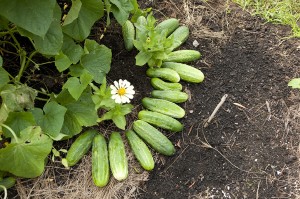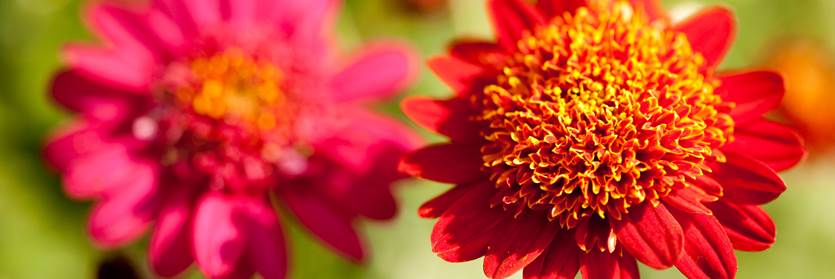Inside The New York Botanical Garden
cucumbers
Posted in Mario Batali's Edible Garden on August 31 2011, by Ann Rafalko
From August 27 – September 25, families can explore Mario Batali’s Edible Garden in the Ruth Rea Howell Family Garden and enjoy daily gardening activities and cooking demonstrations showcasing kid-friendly recipes with the chance to sample and search for ingredients in the garden. We are posting the recipes from Mario Batali’s Edible Garden here on the NYBG blog, Plant Talk, so check back often.
Spicy Cucumber and Fennel Salad
Dan Drohan, Executive Chef, OTTO Enoteca Pizzaria, New York
 Lemon Vinaigrette
Lemon Vinaigrette
1/4 cup fresh lemon juice
1 teaspoon lemon marmellata (marmalade) or a generous pinch of grated lemon zest
1/2 cup extra virgin olive oil, preferably Tuscan
1 fennel bulb, sliced paper thin
2 breakfast radishes, thinly sliced
2 hot house cucumbers, skins on
2 peperoncini, thinly sliced
4 tablespoons Lemon Vinaigrette
Sea salt and freshly ground black pepper, to taste
2 sprigs fennel fronds
Whisk the lemon juice, marmellata, and olive oil together in a small bowl and set aside. The vinaigrette can be refrigerated for up to 3 days.
Using a Japanese mandolin, thinly slice fennel and radishes and set aside in a serving bowl. Split cucumbers lengthwise and cut into 1/2-centimeter-thick half moons, skins on, and transfer to serving bowl. Thinly slice peperoncini on a bias and incorporate. Add all Lemon Vinaigrette, season with salt and pepper and toss lightly. Garnish with fennel fronds and serve.
Posted in Gardening Tips on August 24 2009, by Sonia Uyterhoeven
 |
Sonia Uyterhoeven is Gardener for Public Education. Join her each weekend for home gardening demonstrations on a variety of topics in the Home Gardening Center. |
 Last week I told you of the nutritional merits of beets. Cucumbers can’t make the same clame to nutrition—there is a small amount of vitamin C in a cucumber, but aside from that it is mostly water.
Last week I told you of the nutritional merits of beets. Cucumbers can’t make the same clame to nutrition—there is a small amount of vitamin C in a cucumber, but aside from that it is mostly water.
But don’t despair. Cucumbers often show up in face creams, and you’ve no doubt seen the stereotypical facial with two slices refreshing and covering eyes. Cucumbers with their softening, beautifying, and anti-irritant properties have swept the cosmetic world by storm.
For me, cucumbers remind me of my youth. With my childhood culinary bible, The Joy of Cooking, in hand, I set about in late summer to make my annual batch of pickles, with varying rates of success. I took great pride in growing the pickling cucumbers from seed and then seeing them find their rightful place in the cupboard in a jar surrounded by cider vinegar, dill seed, and garlic.
My sister has one of the best smoothie blender, she would toss cucumbers into the blender to whip up her daily cup of gazpacho. The English serve them for high tea in all their simplicity, lightly salted on open-faced sandwiches with mayonnaise or butter. They are an indispensable part of any good crudités.
There are many types of cucumbers for the home gardener to try. There are fancy heirloom cucumbers such as ‘Lemon’, which looks like a strange hybrid between a lemon and a cuke; pickling cucumbers that range from the size of a cornichon to a 6-inch long spear; Burpless varieties with thin skins and mild flavor that are easier to digest; and Asian varieties that are sweet and long with tiny seeds.
If you are trying to decide between growing a slicing (salad) cucumber and a pickling cucumber but only have space in the garden for one variety, know that pickling cucumbers make excellent slicers and slicing cucumbers can be made into pickles. However, you will need to decide how much space you will dedicate to them. Many of the vining cucumbers easily spread 6–8 feet while the more compact bush varieties cover a 2- to 3-foot area. Bush cucumbers, such as ‘Spacemaster’, ‘Salad Bush’, ‘Bush Champion’, and ‘Parks Bush Whopper’ are ideal for containers. Containers should be at least 12 inches deep and will need to be fertilized every 2 weeks with a fish emulsion.
Read More



